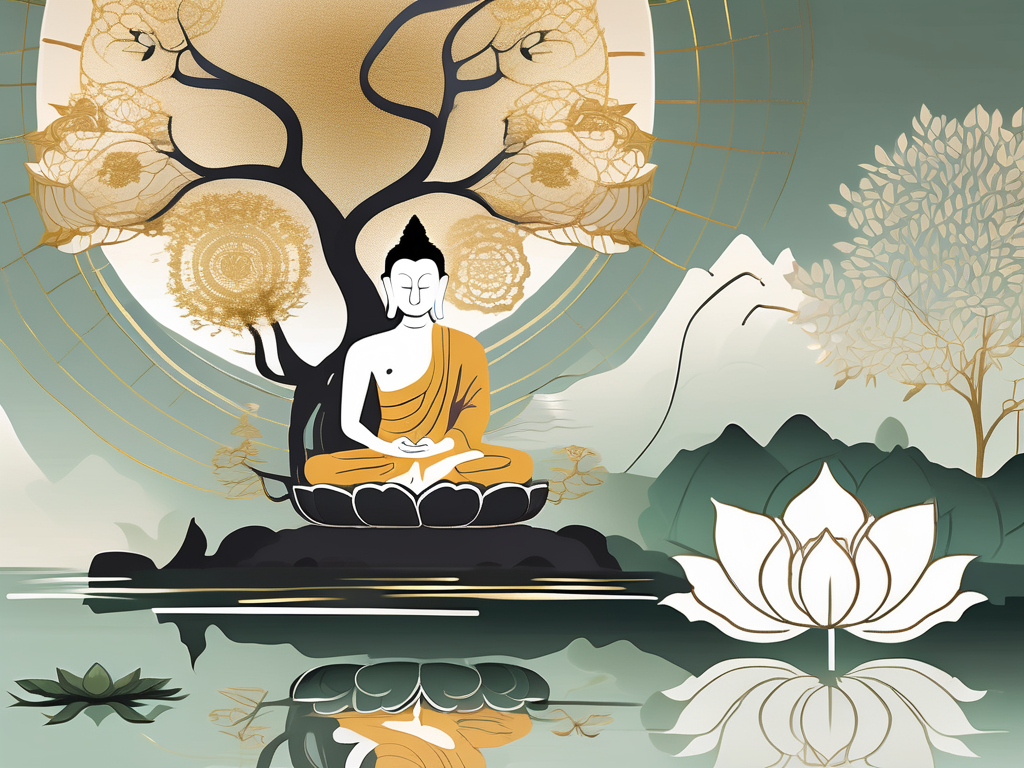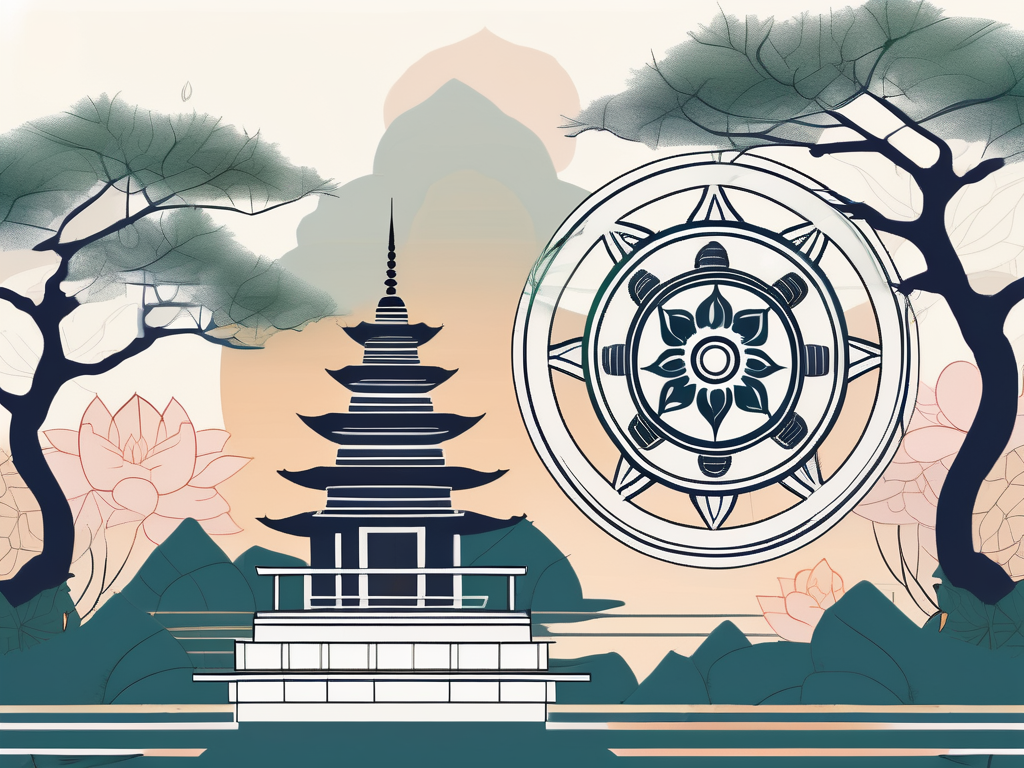Mahayana Buddhism is a fascinating and wide-ranging school of Buddhism that has captivated the hearts and minds of millions of people around the world. In this comprehensive guide, we will delve into the key aspects and principles of Mahayana Buddhism, explore its history and origins, discuss the different schools within Mahayana Buddhism, explore its rituals and practices, and examine its relevance in modern times. So, let’s embark on this enlightening journey and discover the beauty and wisdom of Mahayana Buddhism.
Understanding the Basics of Mahayana Buddhism
Before we dive deep into the intricate details of Mahayana Buddhism, it’s essential to grasp the fundamental concepts that form its philosophical foundation. Mahayana Buddhism, also known as the “Great Vehicle,” emerged as a distinct tradition around the 1st century CE.
The Origins and History of Mahayana Buddhism
It is believed that Mahayana Buddhism originated in the northwestern region of India and gradually spread to various parts of Asia, including China, Japan, Korea, and Vietnam. The historical roots of Mahayana Buddhism can be traced back to the teachings of the historical Buddha, Siddhartha Gautama.
During the early years of Buddhism, there was a growing emphasis on the idea of compassion and the desire to help others. This led to the development of Mahayana Buddhism as a response to the prevailing individualistic approach of Theravada Buddhism. Mahayana Buddhism sought to expand the scope of liberation to include all sentient beings, not just oneself.
Key Principles and Beliefs of Mahayana Buddhism
One of the fundamental principles of Mahayana Buddhism is the concept of Bodhisattva, which refers to an enlightened being who seeks to liberate all living beings from suffering. Unlike Theravada Buddhism, another major branch of Buddhism, which primarily focuses on individual enlightenment, Mahayana Buddhism emphasizes compassion and the desire to help others achieve liberation.
In Mahayana Buddhism, the ultimate goal is not just personal liberation but the liberation of all beings. This is reflected in the Bodhisattva ideal, where practitioners aspire to become Bodhisattvas and dedicate themselves to the welfare and liberation of all sentient beings. This selfless approach is seen as the highest form of spiritual practice in Mahayana Buddhism.
The Role of Bodhisattvas in Mahayana Buddhism
Bodhisattvas are highly revered figures in Mahayana Buddhism. They are seen as beings who have attained a high level of spiritual realization but have chosen to postpone their own enlightenment until all sentient beings are liberated. The aspiration to become a Bodhisattva and assist others on the path to enlightenment is a central theme in Mahayana Buddhism.
In Mahayana Buddhism, Bodhisattvas are considered compassionate guides and protectors. They are believed to possess extraordinary powers and wisdom, which they use to aid those who are suffering. Bodhisattvas are seen as sources of inspiration and role models for practitioners, as they embody the ideals of compassion, wisdom, and selflessness.
Throughout the history of Mahayana Buddhism, numerous Bodhisattvas have been venerated and worshipped. Each Bodhisattva is associated with specific qualities and attributes, and devotees often turn to them for guidance and support in their spiritual journey.
Conclusion
As we can see, Mahayana Buddhism is a rich and complex tradition that places great emphasis on compassion and the desire to help others. The concept of Bodhisattva and the role they play in Mahayana Buddhism highlight the selfless nature of this path. By aspiring to become Bodhisattvas, practitioners aim to cultivate compassion and wisdom, not only for their own benefit but for the benefit of all sentient beings.
The Different Schools of Mahayana Buddhism
As Mahayana Buddhism spread and evolved throughout different regions, it gave rise to various distinct schools, each with its own unique practices and interpretations. Let’s explore some of the prominent schools within Mahayana Buddhism.
Pure Land Buddhism: A Path to Enlightenment
Pure Land Buddhism places great emphasis on devotion and the recitation of sacred chants to attain rebirth in the Pure Land, a celestial realm free from suffering, where enlightenment becomes more accessible.
Within Pure Land Buddhism, there are different variations and practices depending on the region. In Japan, for example, the Jodo Shu and Jodo Shinshu schools are prominent. These schools focus on the belief in Amida Buddha, who is seen as a compassionate figure that guides practitioners towards the Pure Land. Devotees often recite the Nembutsu, a chant that expresses gratitude and reverence towards Amida Buddha.
In China, Pure Land Buddhism is known as Jingtu, and it has its own unique practices. One of the most famous Pure Land Buddhist temples in China is the Longxing Monastery, located in Hebei Province. This ancient temple attracts pilgrims from all over the world who come to experience the serene atmosphere and engage in devotional practices.
Zen Buddhism: The Practice of Meditation
Zen Buddhism, known for its direct approach to enlightenment, places emphasis on meditation and mindfulness in everyday activities. By focusing on the present moment and achieving a state of deep concentration, practitioners seek to attain sudden insight into their true nature.
Within Zen Buddhism, there are different schools that have their own unique practices and lineages. The Rinzai school, for example, is known for its rigorous meditation practices and the use of koans, which are paradoxical questions or statements that help provoke insight. The Soto school, on the other hand, emphasizes the practice of shikantaza, or “just sitting,” where practitioners aim to cultivate awareness without any specific goal or object of focus.
Nichiren Buddhism: The Power of the Lotus Sutra
Nichiren Buddhism centers its teachings around the Lotus Sutra, a revered scripture within Mahayana Buddhism. It emphasizes the chanting of Nam-myoho-renge-kyo as a means to tap into one’s innate Buddha nature and achieve enlightenment in this lifetime.
Within Nichiren Buddhism, there are different organizations and sects that follow the teachings of Nichiren Daishonin, the founder of this school. One of the most well-known organizations is Soka Gakkai International (SGI), which has a global presence and promotes peace, education, and cultural exchange.
SGI members often gather for chanting sessions called gongyo, where they recite portions of the Lotus Sutra and chant Nam-myoho-renge-kyo together. These gatherings create a sense of community and provide support for individuals on their spiritual journey.
Conclusion:
As Mahayana Buddhism spread and evolved, it gave rise to various schools that offered different paths to enlightenment. Pure Land Buddhism emphasizes devotion and sacred chants, Zen Buddhism focuses on meditation and mindfulness, and Nichiren Buddhism centers around the power of the Lotus Sutra and chanting Nam-myoho-renge-kyo. Each school has its own unique practices and interpretations, providing practitioners with diverse approaches to spiritual growth and realization.
Rituals and Practices in Mahayana Buddhism
Mahayana Buddhism encompasses a rich tapestry of rituals and practices that serve as vehicles for spiritual growth and enlightenment. Let’s explore some of the key practices within this tradition.
The Significance of Meditation and Mindfulness
Meditation and mindfulness play crucial roles in Mahayana Buddhism. Through meditation, practitioners cultivate a calm and focused mind, develop insight into the nature of reality, and ultimately achieve enlightenment.
In the practice of meditation, Mahayana Buddhists often find themselves in serene and secluded environments, such as monasteries or dedicated meditation centers. These spaces are carefully designed to foster a sense of tranquility and provide practitioners with the ideal conditions for deep introspection and self-discovery.
During meditation sessions, practitioners typically assume a comfortable seated posture, with their legs crossed and their hands resting gently on their laps. They close their eyes and focus their attention on their breath, allowing the rhythm of inhalation and exhalation to anchor their awareness in the present moment.
As the mind settles, practitioners may choose to direct their attention to specific objects of meditation, such as the sensations of the body, visualizations of deities, or the repetition of sacred mantras. By engaging with these objects, practitioners deepen their concentration and cultivate qualities such as compassion, loving-kindness, and wisdom.
The Role of Chanting and Mantras
Chanting sacred texts and mantras, such as the famous “Om Mani Padme Hum,” is widely practiced in Mahayana Buddhism. It is believed that the recitation of these powerful sounds helps purify the mind, generate positive energy, and bring about spiritual transformation.
Chanting sessions often take place in temples or monastic settings, where practitioners gather to collectively engage in this devotional practice. The rhythmic repetition of sacred sounds creates a harmonious and uplifting atmosphere, allowing individuals to connect with the divine and experience a sense of unity with all beings.
Mantras, in particular, hold a special place in Mahayana Buddhism. These sacred syllables or phrases are believed to embody the essence of enlightened beings and carry their blessings. By reciting mantras, practitioners invoke the qualities and wisdom of these enlightened beings, seeking their guidance and protection on the spiritual path.
Understanding Buddhist Festivals and Ceremonies
Throughout the year, Mahayana Buddhists celebrate various festivals and engage in meaningful ceremonies. These events provide opportunities for teachings, community bonding, and the expression of gratitude towards the Buddha and the Dharma.
One such festival is Vesak, which commemorates the birth, enlightenment, and passing away of the historical Buddha, Siddhartha Gautama. During Vesak, devotees gather at temples to participate in rituals, listen to teachings, and engage in acts of generosity, such as offering food to monks and the less fortunate.
Another significant event in Mahayana Buddhism is the Ullambana Festival, also known as the Ghost Festival. This festival is dedicated to honoring and making offerings to deceased ancestors and wandering spirits. It is believed that by performing acts of generosity and offering prayers, one can alleviate the suffering of these beings and help them find peace.
Other ceremonies in Mahayana Buddhism include the ordination of monks and nuns, the consecration of sacred statues and relics, and the recitation of sutras. These ceremonies serve as important milestones in the spiritual journey of practitioners and provide opportunities for deepening their commitment to the Buddhist path.
Mahayana Buddhism in Modern Times
Mahayana Buddhism continues to flourish in contemporary society, transcending geographical boundaries and resonating with people from diverse cultural backgrounds. Let’s explore its impact in the modern world.
The Spread of Mahayana Buddhism Around the World
From its humble origins, Mahayana Buddhism has spread far and wide, finding its way to many countries worldwide. Its teachings and practices have resonated with individuals seeking spiritual fulfillment and a deeper understanding of themselves and the world around them.
One such country where Mahayana Buddhism has taken root is Japan. The influence of this branch of Buddhism can be seen in various aspects of Japanese culture, from the iconic Zen gardens to the serene temples nestled amidst bustling cities. The teachings of Mahayana Buddhism have become an integral part of the Japanese way of life, shaping their values and guiding their actions.
In China, Mahayana Buddhism has also left an indelible mark. The famous Mogao Caves in Dunhuang, with their intricate murals and statues, stand as a testament to the devotion and artistic expression inspired by this spiritual tradition. The spread of Mahayana Buddhism in China has not only influenced religious practices but has also had a profound impact on art, literature, and philosophy.
Mahayana Buddhism and Contemporary Society
In modern times, Mahayana Buddhism has adapted to address the challenges and complexities of the present era. Its teachings on compassion, social justice, and interconnectedness inspire many to engage in activities that promote peace, harmony, and the well-being of all sentient beings.
One example of Mahayana Buddhism’s impact on contemporary society can be seen in the rise of engaged Buddhism. This movement, spearheaded by influential figures such as Thich Nhat Hanh, encourages practitioners to actively participate in social and environmental issues. Engaged Buddhists strive to alleviate suffering and create positive change in the world, embodying the compassionate ideals of Mahayana Buddhism.
The Future of Mahayana Buddhism: Challenges and Opportunities
As we look to the future, Mahayana Buddhism faces both challenges and opportunities. With rapid globalization, technological advancements, and shifting societal values, it is important for Mahayana Buddhism to adapt while staying true to its core teachings and values.
One of the challenges Mahayana Buddhism faces is the increasing secularization of society. As people become more focused on material pursuits and instant gratification, the spiritual teachings of Mahayana Buddhism may struggle to find relevance in their lives. However, this challenge also presents an opportunity for Mahayana Buddhism to offer a path of inner peace and fulfillment amidst the chaos and distractions of the modern world.
Furthermore, the advancements in technology provide new avenues for the dissemination of Mahayana Buddhist teachings. Online platforms, social media, and digital resources enable practitioners to connect with like-minded individuals, access teachings from revered masters, and deepen their understanding of Mahayana Buddhism.
In conclusion, Mahayana Buddhism offers a profound spiritual path that emphasizes compassion, enlightenment, and the welfare of all beings. Its rich history, diverse schools, and meaningful rituals capture the hearts and minds of its followers. As we continue to navigate our lives in an ever-changing world, the wisdom and teachings of Mahayana Buddhism provide solace, guidance, and inspiration for those seeking inner peace and enlightenment. So, immerse yourself in the wisdom of Mahayana Buddhism and discover the transformative power it holds.












